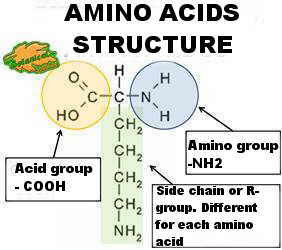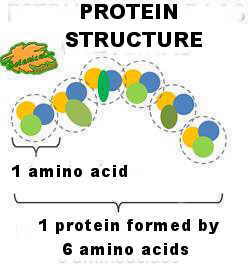Contents
Uses of amino acids
WHAT ARE AMINO ACIDS?
Amino acids are organic compounds units which, joined together, form proteins.
Attached amino acids form larger molecules (proteins) necessary for the existence, operation and maintenance of our body.
There are many different proteins, depending on the different combinations of amino acids.
Amino acid structure

Chemical structure of an amino acid. Marked the carboxyl group (yellow), amino group (blue) and the chain or radical (green). All amino acids have an amino group and an acid group. They differ from each other by the structure of its chain. Sometimes the chain contains sulfur atoms (sulfur-containing amino acids)
Its structure consists of 3 parts:
– The chain, radical or R group (-CHR-): The part that differentiates the different amino acids.
The other two parts of the molecule are the same for all amino acids:
– Amino group: The molecule terminates with an amino group. In chemistry, an amino group -NH2 is represented as +
– Carboxyl group or acid group represented by -COOH at the beginning.
Amino acids are linked together by peptide bonds forming long chains of tens or hundreds of amino acids (proteins). The peptide bond takes place between a carbon atom (carboxyl group) and nitrogen (amino group). This link, covalent type, is very stable and sturdy, making it possible to form large molecules can.
* More information: Protein structure

Chemical structure of a protein. It consists of units (amino acids). In each amino acid, is differentiated the carboxyl group (yellow), the amino group (blue) and its chain (green). Different proteins are obtained from different combinations of amino acids.
Characteristics of amino acids
Properties of a protein vary depending on the combination of amino acids containing the chain, since each protein has its own chemical and physical characteristics.
Amino acids have amphoteric properties, ie, can act as both acids or bases in aqueous medium or a solution depending on the pH thereof.
* More information on properties of amino acids.
Types of amino acids
There are 20 different aminoacids. Their many possible combinations result in a myriad of resulting proteins. There are 2 types of amino acids.
Usually they classified as essential and nonessential amino acids, but also usually classified according to their polarity.
To refer to amino acids in a simpler way, they are represented by three letters. For example, Arg for arginine.
Essential amino acids
Essential amino acids encompass 9 types of amino acids that share a common characteristic: that our body can not synthesize by itself and requires their intake through food, to perform more complex proteins and perform multiple functions in the body.
The list of essential amino acids is:
Nonessential amino acids
Nonessential amino acids are those that our organism can synthesize by itself from other amino acids, or protein substances. It should be clarified that, although not essential, insufficient protein intake may trigger deficit of these amino acids.
The list of non-essential amino acids is as follows:
Other amino acids
* Related information:
– How to combine vegetable proteins
![]() More information on amino acids.
More information on amino acids.








